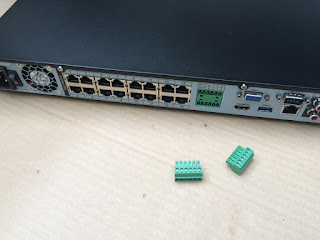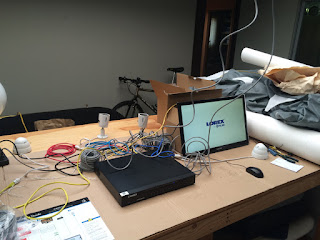I have been wanting a security camera system a long time. Over the years I have monitor the progress of the improvements on those of consumer budget but have defer the purchase as I felt they are not good enough. I recently picked up this Night Owl 8-channel DVR with 4 HD analog cameras for only $250. I have a lot of reservation, especially the challenges of running the BNC/power cables between the DVR and the cameras. Upon inspecting the cable interconnect I decided to return it without evening opening up the rest of the system. I started researching on the newer generation of network video recorders (NVR).
It was very tempting to settle on the $250 4-camera Night Owl HD DVR. With the low price, there are many drawbacks. The system requires 2 external power adapters. One adapter is for the 4 cameras, and the other for the DVR box. I hate all the loose pieces but that is what you get for that price point.
the NVR system arrived - i didn't expect the package to be this big; the flip flop serves as a scale reference
the so called 3MP camera - stem type; the interface is PoE so one only need a CAT5E cable; the smaller jack in the photo is for external 12V power if the Ethernet connection does not have PoE
the so called 3MP camera - dome type
the back side of the dome camera
the reason the package is so big because there are 9 cameras and 9 spools of 100-foot cat5e cable
the back side of the NVR
this unit has external trigger inputs as well as trigger outputs
The main reason that I opted for a NVR is the flexibility of how the cameras can be connected to the NVR. Each camera is a network camera with Ethernet interface. The video capture and compression are all done within the camera. The camera obtain the power from the CAT5e Ethernet cable which also functions as the network data link, as only as it is plugged into a PoE (Power Over Ethernet) port. It is much easier to run Ethernet cable than running a cable with video coax and power as in the case of the analog HD cameras. If the cables are exposed to the outdoors elements they will fail after many years. Ethernet cables are cheap and easy to replace.
It is all too easy to fall for a lot of cameras until you begin installing them and wiring them up. This NVR has 16 camera ports all has PoE. Some other brand may only have PoE on half of the ports. However to bring all 16 cameras to the NVR is often not what you want to do as the cable bundle is very big. There comes another benefit of the NVR. You can reduce the number of cabling between the NVR to another area of the premise by using an Ethernet switch. For example, you can place the NVR at one end of the premise and the Ethernet switch at another end of the premise close to where the cameras are located. The cameras are then connected to the Ethernet switch. The Ethernet switch in turn acts as the bridge between the cameras and the NVR, reducing the number of cable run down to only 1.
an example of connecting IP cameras through a PoE switch
I am in the process of evaluating the NVR system. I am
One key function that I is high on the check list is the proper functioning with a POE Ethernet switch. I begun doing research for a small Gigabit Ethernet PoE switch. My thought is an 8-port switch would be ideal to meet my need. I typically like Netgear and LinkSys though I have varied experience with both brands. Immediately I am unimpressed with their offering. Both sells 8-port switches but only 4 of the 8 ports are PoE.
this 8-port Netgear only has 4 PoE ports
this one has 89 PoE but the price is double
a no-name brand 8-port PoE costs about the same as the 4 PoE port Netgear or LinkSys
While I don't yet have a PoE network switch to test with, I tried to test the camera connecting to the network and not directly to the NVR's camera ports. It dawns on me that I can just use my now-trusty SBG6850 cable modem with integrated router. I plugged a camera into one of the three remaining ports. I spent some time fussing with the NVR but unable to find the camera. I scratch my head and wondered what gives. Duh! While these 4 ports are Gigabit, they are not PoE. I scrounged a 12V power supply to power this camera and it works.
While it seems to be more expense and equipment involves with the used of a Ethernet switch or router, the reduction of multitude of cables between the camera is well worth the extra cost. The other less obvious benefit is should the criminal enter your premise and decides to destroy the camera system. A NVR that does not connect to the cameras directly is that much harder for him to find.














No comments:
Post a Comment